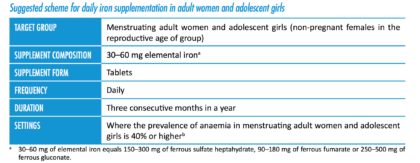- Home
- Editorial
- News
- Practice Guidelines
- Anesthesiology Guidelines
- Cancer Guidelines
- Cardiac Sciences Guidelines
- Critical Care Guidelines
- Dentistry Guidelines
- Dermatology Guidelines
- Diabetes and Endo Guidelines
- Diagnostics Guidelines
- ENT Guidelines
- Featured Practice Guidelines
- Gastroenterology Guidelines
- Geriatrics Guidelines
- Medicine Guidelines
- Nephrology Guidelines
- Neurosciences Guidelines
- Obs and Gynae Guidelines
- Ophthalmology Guidelines
- Orthopaedics Guidelines
- Paediatrics Guidelines
- Psychiatry Guidelines
- Pulmonology Guidelines
- Radiology Guidelines
- Surgery Guidelines
- Urology Guidelines
WHO guideline on Daily Iron Supplements in adult women and adolescent girls

Globally, one in three non-pregnant women, corresponding to almost 500 million women, were anaemic in 2011. Iron de ciency is thought to contribute to at least half of the global burden of anaemia. Iron de ciency occurs following prolonged nega ve iron balance, the major causes of which include inadequate intake (owing to insu cient bioavailable iron in the diet or decreased iron absorp on), increased iron requirements (for instance, during periods of growth) and chronic blood loss (from heavy hookworm infec on or menstrual bleeding). In adolescent girls, menstrual blood losses, accompanied by rapid growth with expansion of the red cell mass and increased ssue iron requirements, make them par cularly vulnerable to iron de ciency compared to male counterparts.
In 2016, WHO has published guidelines for Daily Iron Supplements in adult women and adolescent girls. Following are its recommendations:-
Daily iron supplementation is recommended as a public health intervention in menstruating adult women and adolescent girls, living in settings where anaemia is highly prevalent (≥40% anaemia prevalence), for the prevention of anaemia and iron deficiency (strong recommenda on, moderate quality of evidence).
 Source: WHO
Source: WHORemarks
- Daily oral iron supplementation on is a preventive strategy for implementation at the population level. If a menstruating woman or adolescent girl is diagnosed with anaemia, national guidelines for the treatment of anaemia should be followed.
- Daily iron supplementation should be considered in the context of other interventions containing iron (fortified foods, multiple micronutrient powders, lipid-based nutrient supplements).
- The selection of the most appropriate delivery platform should be context specific, with the aim of reaching the most vulnerable populations and ensuring a timely and continuous supply of supplements.
- All women, from the moment they begin trying to conceive until 12 weeks of gestation, should take a folic acid supplement. Daily oral iron and folic acid supplementation should be part of routine antenatal care, begun as early as possible and continued throughout pregnancy. Where the prevalence of anaemia in pregnant women is high (40% or more), supplementation should continue for 3 months in the postpartum period
Next Story
NO DATA FOUND

Disclaimer: This site is primarily intended for healthcare professionals. Any content/information on this website does not replace the advice of medical and/or health professionals and should not be construed as medical/diagnostic advice/endorsement or prescription. Use of this site is subject to our terms of use, privacy policy, advertisement policy. © 2020 Minerva Medical Treatment Pvt Ltd